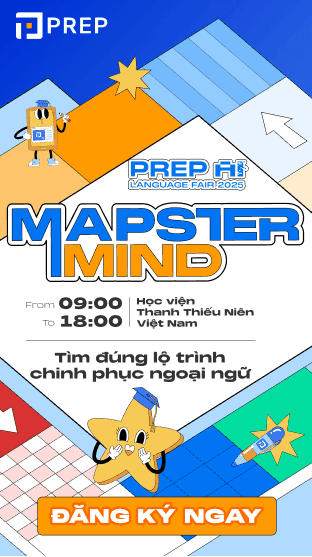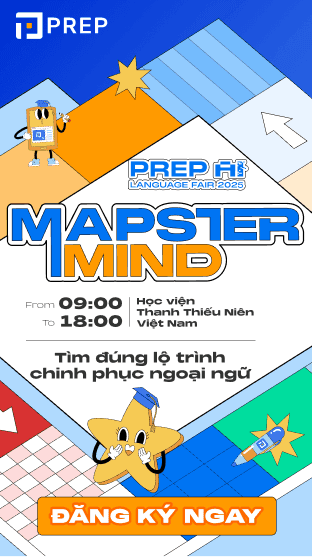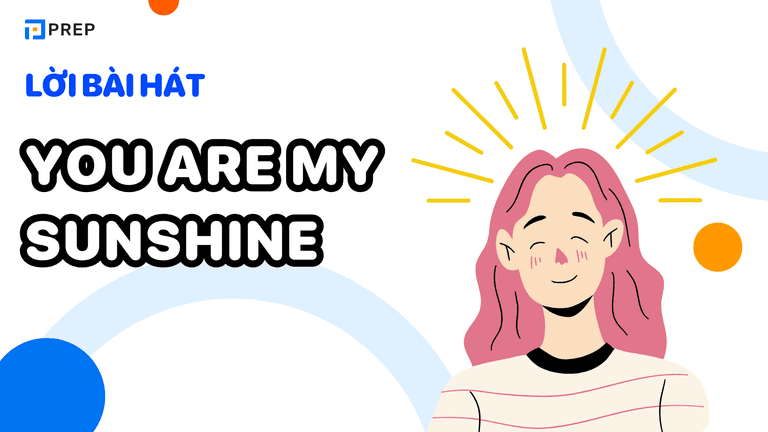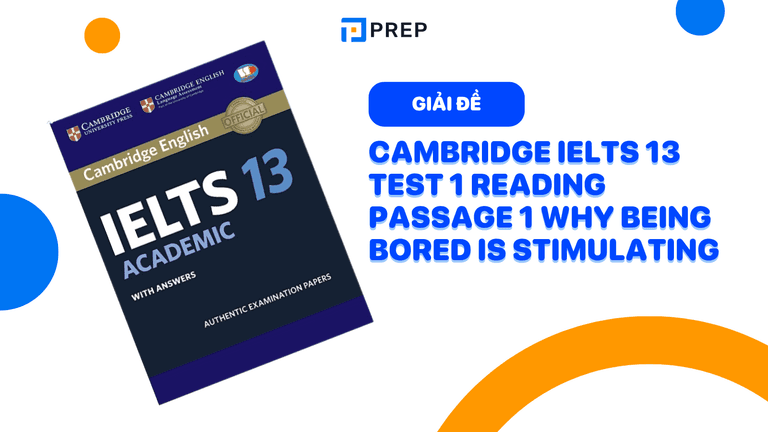Đề bài và đáp án IELTS Cambridge 13 Test 1 Reading Passage 3 Artificial artists
Bài đọc IELTS Cambridge 13 Test 1 Reading Passage 3 Artificial Artists là chủ đề khá khó, nhiều từ vựng chuyên ngành mới. Dưới đây là bài tổng hợp đề bài, đáp án giải thích chi tiết và những từ vựng hay trong bài cần ghi nhớ mà bạn có thể tham khảo qua để luyện thi IELTS hiệu quả hơn, đặc biệt là kỹ năng Reading.
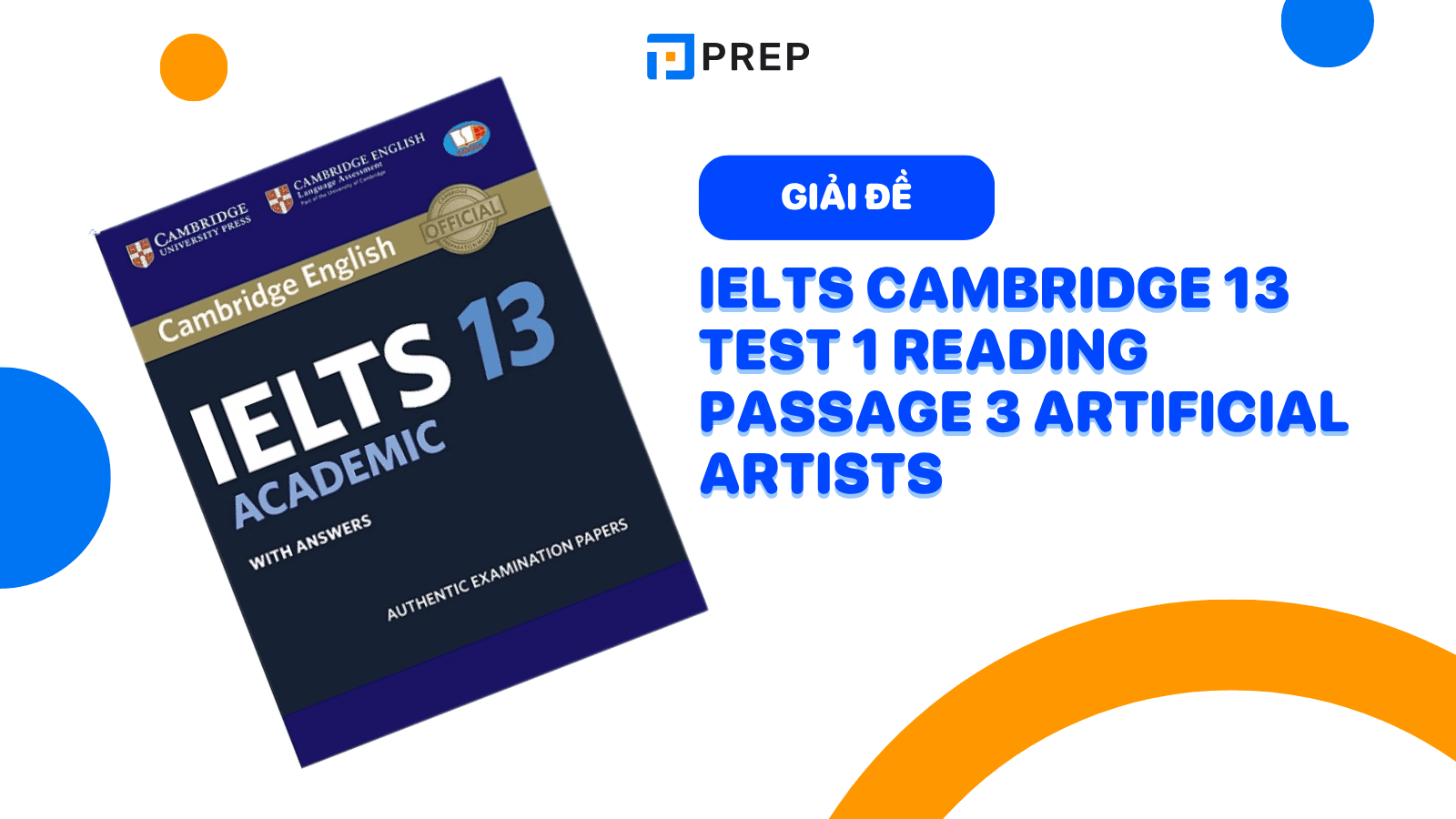
I. Đề bài IELTS Cambridge 13 Test 1 Reading Passage 3 Artificial artists
Reading Artificial artists
Artificial artists
Can computers really create works of art?
The Painting Fool is one of a growing number of computer programs which, so their makers claim, possess creative talents. Classical music by an artificial composer has had audiences enraptured, and even tricked them into believing a human was behind the score. Artworks painted by a robot have sold for thousands of dollars and been hung in prestigious galleries. And software has been built which creates art that could not have been imagined by the programmer.
Human beings are the only species to perform sophisticated creative acts regularly. If we can break this process down into computer code, where does that leave human creativity? ‘This is a question at the very core of humanity,’ says Geraint Wiggins, a computational creativity researcher at Goldsmiths, University of London. ‘It scares a lot of people. They are worried that it is taking something special away from what it means to be human.’
To some extent, we are all familiar with computerised art. The question is: where does the work of the artist stop and the creativity of the computer begin? Consider one of the oldest machine artists, Aaron, a robot that has had paintings exhibited in London’s Tate Modern and the San Francisco Museum of Modern Art. Aaron can pick up a paintbrush and paint on canvas on its own. Impressive perhaps, but it is still little more than a tool to realise the programmer’s own creative ideas.
Simon Colton, the designer of the Painting Fool, is keen to make sure his creation doesn’t attract the same criticism. Unlike earlier ‘artists’ such as Aaron, the Painting Fool only needs minimal direction and can come up with its own concepts by going online for material. The software runs its own web searches and trawls through social media sites. It is now beginning to display a kind of imagination too, creating pictures from scratch. One of its original works is a series of fuzzy landscapes, depicting trees and sky. While some might say they have a mechanical look, Colton argues that such reactions arise from people’s double standards towards software-produced and human-produced art. After all, he says, consider that the Painting Fool painted the landscapes without referring to a photo. ‘If a child painted a new scene from its head, you’d say it has a certain level of imagination,’ he points out. ‘The same should be true of a machine.’
Software bugs can also lead to unexpected results. Some of the Painting Fool’s paintings of a chair came out in black and white, thanks to a technical glitch. This gives the work an eerie, ghostlike quality. Human artists like the renowned Ellsworth Kelly are lauded for limiting their colour palette – so why should computers be any different?
Researchers like Colton don't believe it is right to measure machine creativity directly to that of humans who "have had millennia to develop our skills". Others, though, are fascinated by the prospect that a computer might create something as original and subtle as our best artists. So far, only one has come close. Composer David Cope invented a program called Experiments in Musical Intelligence, or EMI. Not only did EMI create compositions in Cope's style, but also that of the most revered classical composers, including Bach, Chopin and Mozart. Audiences were moved to tears, and EMI even fooled classical music experts into thinking they were hearing genuine Bach. Not everyone was impressed however. Some, such as Wiggins, have blasted Cope's work as pseudoscience, and condemned him for his deliberately vague explanation of how the software worked. Meanwhile, Douglas Hofstadter of Indiana University said EMI created replicas which still rely completely on the original artist's creative impulses. When audiences found out the truth they were often outraged with Cope, and one music lover even tried to punch him. Amid such controversy, Cope destroyed EMI's vital databases.
But why did so many people love the music, yet recoil when they discovered how it was composed? A study by computer scientist David Moffat of Glasgow Caledonian University provides a clue. He asked both expert musicians and non-experts to assess six compositions. The participants weren't told beforehand whether the tunes were composed by humans or computers, but were asked to guess, and then rate how much they liked each one. People who thought the composer was a computer tended to dislike the piece more than those who believed it was human. This was true even among the experts, who might have been expected to be more objective in their analyses.
Where does this prejudice come from? Paul Bloom of Yale University has a suggestion: he reckons part of the pleasure we get from art stems from the creative process behind the work. This can give it an "irresistible essence", says Bloom. Meanwhile, experiments by Justin Kruger of New York University have shown that people's enjoyment of an artwork increases if they think more time and effort was needed to create it. Similarly, Colton thinks that when people experience art, they wonder what the artist might have been thinking or what the artist is trying to tell them. It seems obvious, therefore, that with computers producing art, this speculation is cut short — there's nothing to explore. As technology becomes increasingly complex, says Colton, those greater depths in computer art could become possible. This is precisely why Colton asks the Painting Fool to tap into online social networks for its inspiration: hopefully this way it will choose themes that will already be meaningful to us.
Questions 27-31
Choose the correct letter, A, B, C, or D.
Write the correct letter in boxes 27-31 on your answer sheet.
27. What is the writer suggesting about computer-produced works in the first paragraph?
A. People's acceptance of them can vary considerably.
B. A great deal of progress has already been attained in this field.
C. They have had more success in some artistic genres than in others.
D. The advances are not as significant as the public believes them to be.
28. According to Geraint Wiggins, why are many people worried by computer art?
A. It is aesthetically inferior to human art.
B. It may ultimately supersede human art.
C. It undermines a fundamental human quality.
D. It will lead to a deterioration in human ability.
29. What is a key difference between Aaron and the Painting Fool?
A. its programmer's background
B. public response to its work
C. the source of its subject matter
D. the technical standard of its output
30. What point does Simon Colton make in the fourth paragraph?
A. Software-produced art is often dismissed as childish and simplistic.
B. The same concepts of creativity should not be applied to all forms of art.
C. It is unreasonable to expect a machine to be as imaginative as a human being.
D. People tend to judge computer art and human art according to different criteria.
31. The writer refers to the paintings of a chair as an example of computer art which
A. achieves a particularly striking effect.
B. exhibits a certain level of genuine artistic skill.
C. closely resembles that of a well-known artist.
D. highlights the technical limitations of the software.
Questions 32-37
Complete each sentence with the correct ending, A-G below.
Write the correct letter, A-G, in boxes 32-37 on your answer sheet.
32. Simon Colton says it is important to consider the long-term view when
33. David Cope's EMI software surprised people by
34. Geraint Wiggins criticised Cope for not
35. Douglas Hofstadter claimed that EMI was
36. Audiences who had listened to EMI's music became angry after
37. The participants in David Moffat's study had to assess music without
List of Ideas
A. generating work that was virtually indistinguishable from that of humans.
B. knowing whether it was the work of humans or software.
C. producing work entirely dependent on the imagination of its creator.
D. comparing the artistic achievements of humans and computers.
E. revealing the technical details of his program.
F. persuading the public to appreciate computer art.
G. discovering that it was the product of a computer program.
Questions 38-40
Do the following statements agree with the claims of the writer in Reading Passage 3?
In boxes 38-40 on your answer sheet, write
-
YES if the statement agrees with the claims of the writer
-
NO if the statement contradicts the claims of the writer
-
NOT GIVEN if it is impossible to say what the writer thinks about this
38. Moffat's research may help explain people's reactions to EMI.
39. The non-experts in Moffat's study all responded in a predictable way.
40. Justin Kruger's findings cast doubt on Paul Bloom's theory about people's prejudice towards computer art.
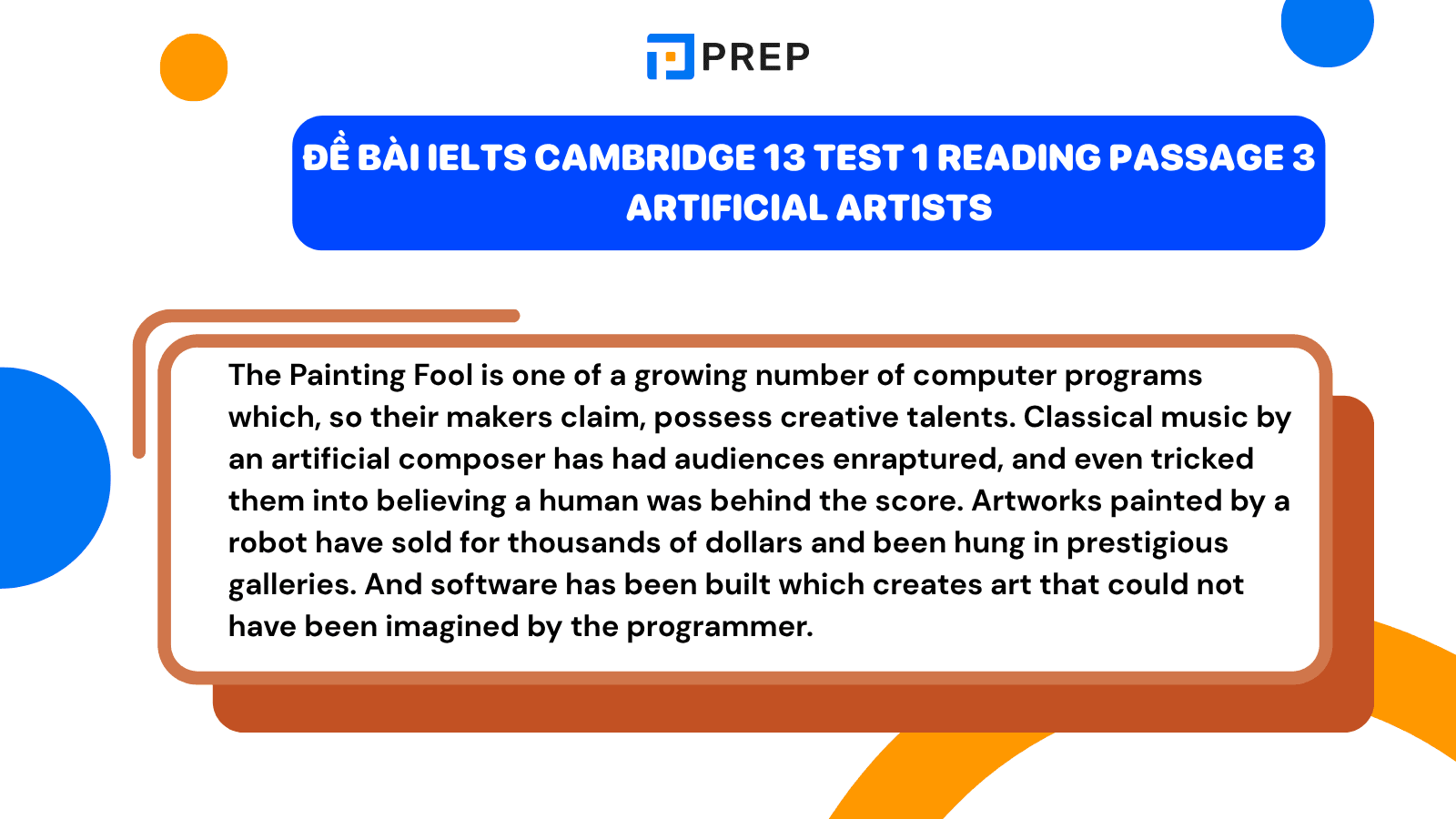
II. Đáp án bài đọc IELTS Cambridge 13 Test 1 Reading Passage 3 Artificial artists
Reading Passage 3, Questions 27-40
-
B
-
C
-
C
-
D
-
D
-
A
-
D
-
E
-
C
-
G
-
B
-
YES
-
NOT GIVEN
-
NO
III. Giải thích đáp án chi tiết bài đọc Artificial artists
Tham khảo phần giải thích đáp án chi tiết dưới đây:
27. B – A great deal of progress has already been attained in this field.
Đoạn đầu mô tả hàng loạt thành tựu của máy tính trong âm nhạc và hội họa: tác phẩm được trưng bày, bán, thậm chí khiến khán giả nhầm tưởng là do người tạo ra. Điều này cho thấy đã có nhiều tiến bộ đáng kể.
28. C – It undermines a fundamental human quality.
Geraint Wiggins nói rằng con người sợ máy móc “lấy đi điều gì đó đặc biệt về bản chất con người” → tức là làm suy yếu phẩm chất đặc trưng của loài người – sự sáng tạo.
29. C – the source of its subject matter.
Aaron chỉ thực hiện ý tưởng của lập trình viên, còn The Painting Fool tự tìm chủ đề bằng cách tra cứu Internet → khác nhau ở nguồn cảm hứng.
30. D – People tend to judge computer art and human art according to different criteria.
Colton lập luận rằng phản ứng tiêu cực với tranh của phần mềm bắt nguồn từ tiêu chuẩn kép (double standards) khi so sánh máy với người.
31. D – highlights the technical limitations of the software.
Ví dụ tranh vẽ chiếc ghế bị lỗi kỹ thuật khiến ảnh trắng đen, nhưng điều này làm nổi bật giới hạn kỹ thuật của phần mềm.
32. A – generating work that was virtually indistinguishable from that of humans.
Colton nói không nên so sánh trực tiếp sáng tạo máy và người, cần nhìn dài hạn → “consider the long-term view” khi máy có thể tạo ra tác phẩm giống người thật.
33. D – comparing the artistic achievements of humans and computers.
EMI khiến mọi người ngạc nhiên khi có thể tạo ra âm nhạc như người thật, khiến nhiều người so sánh thành tựu nghệ thuật của người và máy.
34. E – revealing the technical details of his program.
Wiggins chỉ trích Cope vì không giải thích rõ phần mềm hoạt động thế nào → thiếu minh bạch về chi tiết kỹ thuật.
35. C – producing work entirely dependent on the imagination of its creator.
Hofstadter cho rằng EMI chỉ là bản sao phụ thuộc vào sự sáng tạo ban đầu của người nghệ sĩ.
36. G – discovering that it was the product of a computer program.
Khán giả tức giận khi biết rằng bản nhạc xúc động kia không phải của con người mà do máy sáng tác.
37. B – knowing whether it was the work of humans or software.
Trong nghiên cứu của Moffat, người tham gia không biết ai là tác giả thật của bản nhạc.
38. YES
Moffat’s research giúp giải thích vì sao con người phản ứng mạnh khi biết tác phẩm do máy sáng tác → “provides a clue”.
39. NOT GIVEN
Không có chi tiết nào cho thấy nhóm không chuyên phản ứng theo cách “predictable”.
40. NO
Kruger’s findings ủng hộ (không phủ định) giả thuyết của Bloom – rằng con người đánh giá cao tác phẩm khi biết có nhiều công sức bỏ ra.
Xem thêm: Đề bài và đáp án bài đọc Cambridge IELTS 13 Test 1 Reading Passage 1 Why being bored is stimulating
IV. Từ vựng hay trong bài cần ghi nhớ
Dưới đây là một số từ vựng hay trong bài cần ghi nhớ.
|
Từ vựng |
Nghĩa tiếng Việt |
Ví dụ minh họa |
|
possess creative talents |
có khả năng sáng tạo |
The Painting Fool is said to possess creative talents similar to human artists. (Phần mềm The Painting Fool được cho là có khả năng sáng tạo tương tự như các nghệ sĩ con người.) |
|
enraptured |
mê mẩn, say sưa |
The audience was enraptured by the computer-generated symphony. (Khán giả đã say sưa trước bản giao hưởng được tạo ra bởi máy tính.) |
|
prestigious galleries |
phòng trưng bày danh giá |
Some robot paintings were exhibited in prestigious galleries like the Tate Modern. (Một số bức tranh do robot vẽ đã được trưng bày trong các phòng trưng bày danh giá như Tate Modern.) |
|
break down into computer code |
chuyển đổi thành mã máy tính |
Researchers try to break down human creativity into computer code. (Các nhà nghiên cứu cố gắng chuyển đổi sự sáng tạo của con người thành mã máy tính.) |
|
sophisticated creative acts |
hành động sáng tạo tinh vi |
Humans are the only species capable of performing sophisticated creative acts. (Con người là loài duy nhất có thể thực hiện các hành động sáng tạo tinh vi.) |
|
double standards |
tiêu chuẩn kép |
People often apply double standards when judging computer and human art. (Mọi người thường áp dụng tiêu chuẩn kép khi đánh giá nghệ thuật của máy tính và con người.) |
|
technical glitch |
lỗi kỹ thuật nhỏ |
A technical glitch caused the paintings to appear in black and white. (Một lỗi kỹ thuật nhỏ khiến các bức tranh xuất hiện dưới dạng đen trắng.) |
|
lauded for |
được ca ngợi vì |
Ellsworth Kelly was lauded for his minimal use of color. (Ellsworth Kelly được ca ngợi vì cách sử dụng màu sắc tối giản của ông.) |
|
millennia |
hàng thiên niên kỷ |
Humans have had millennia to develop their artistic skills. (Con người đã có hàng thiên niên kỷ để phát triển kỹ năng nghệ thuật của mình.) |
|
pseudoscience |
giả khoa học |
Some critics called Cope’s experiment a form of pseudoscience. (Một số nhà phê bình gọi thí nghiệm của Cope là một dạng giả khoa học.) |
|
recoil |
chùn lại, phản ứng dữ dội |
People loved the music but recoiled when they learned it was composed by a computer. (Mọi người yêu thích bản nhạc nhưng lại phản ứng dữ dội khi biết nó được sáng tác bởi máy tính.) |
|
prejudice |
định kiến |
There is still strong prejudice against computer-generated art. (Vẫn tồn tại định kiến mạnh mẽ đối với nghệ thuật do máy tính tạo ra.) |
|
irresistible essence |
bản chất hấp dẫn không thể cưỡng lại |
Paul Bloom believes that art has an irresistible essence linked to the artist’s effort. (Paul Bloom tin rằng nghệ thuật có một bản chất hấp dẫn không thể cưỡng lại, gắn liền với nỗ lực của nghệ sĩ.) |
|
speculation is cut short |
sự suy đoán bị chấm dứt |
When art is produced by machines, our speculation about the artist’s thoughts is cut short. (Khi nghệ thuật được tạo ra bởi máy móc, sự suy đoán của chúng ta về ý nghĩ của nghệ sĩ bị chấm dứt.) |
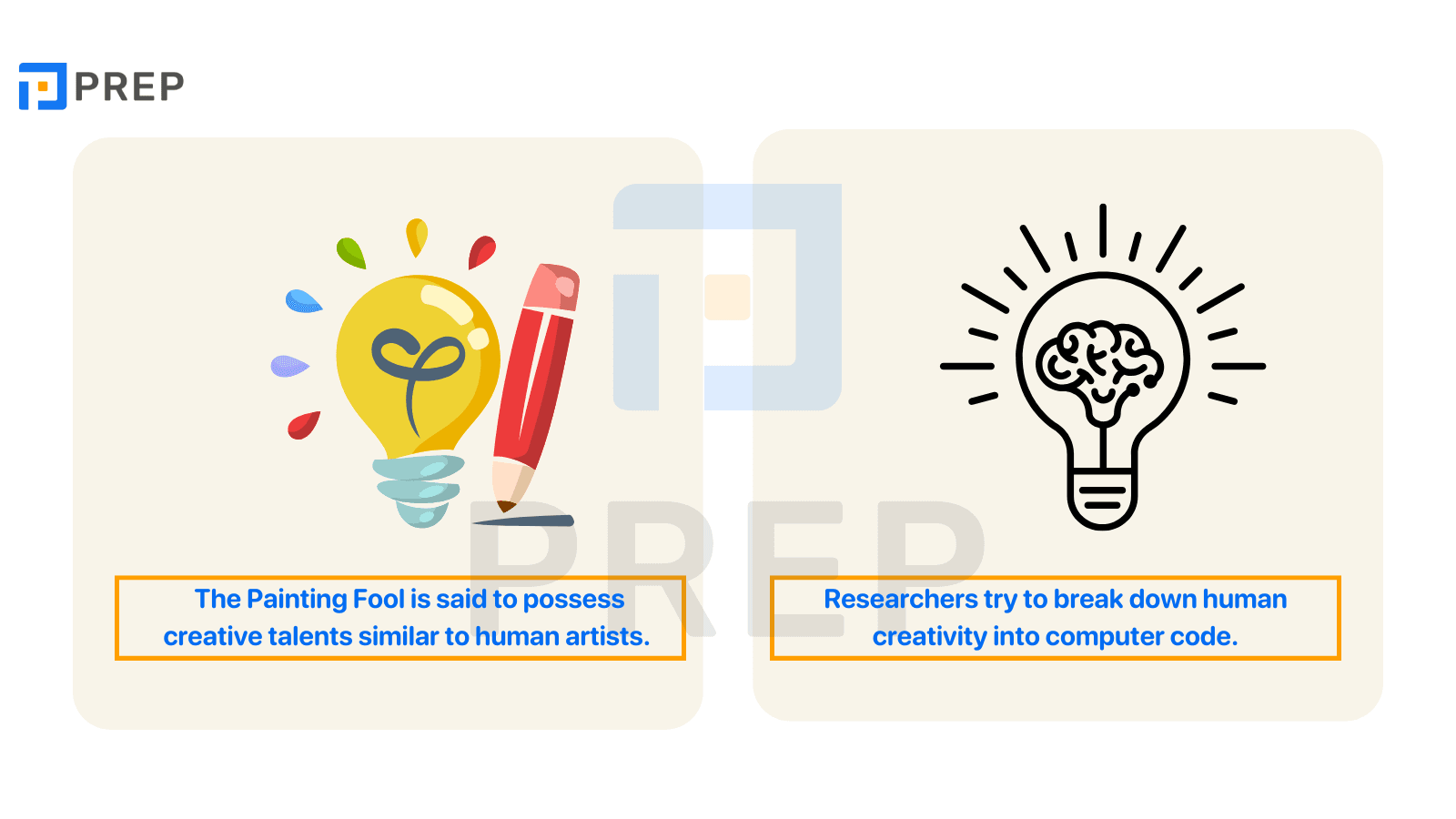
Trên đây là đề bài và đáp án chi tiết bài đọc Cambridge 13 IELTS Test 1 Reading Passage 3 Artificial artists. Hy vọng tài liệu trên sẽ hữu ích cho bạn trong quá trình luyện thi IELTS và chinh phục được band điểm cao như mong đợi.
Học tiếng Anh online dễ dàng hơn với PREP - Nền tảng Học & Luyện thi thông minh cùng AI. Nhờ công nghệ AI độc quyền, bạn có thể tự học trực tuyến ngay tại nhà, chinh phục lộ trình học IELTS, TOEIC, tiếng Anh giao tiếp hiệu quả. Bên cạnh đó, học viên còn có sự hỗ trợ tuyệt vời từ Teacher Bee AI, trợ lý ảo giúp bạn giải đáp thắc mắc và đồng hành 1-1 trong suốt quá trình học tập. Hãy click TẠI ĐÂY hoặc liên hệ HOTLINE 0931428899 để nhận tư vấn chi tiết về các khóa học tiếng Anh chất lượng nhất thị trường!
Tải ngay app PREP để bắt đầu hành trình học tiếng Anh tại nhà với chương trình học luyện thi online chất lượng cao.

Chào bạn! Mình là Hiền Hoàng, hiện đang đảm nhận vai trò quản trị nội dung sản phẩm tại Blog của website prepedu.com.
Với hơn 5 năm tự học các ngoại ngữ như tiếng Anh, tiếng Trung và ôn luyện một số kỳ thi IELTS, TOEIC, HSK, mình đã tự đúc rút được nhiều kinh nghiệm để hỗ trợ hàng nghìn người đang gặp khó khăn trong việc học ngoại ngữ. Hy vọng rằng những chia sẻ phía trên sẽ giúp ích cho bạn trong quá trình tự ôn luyện thi hiệu quả tại nhà!
Bình luận
Nội dung premium
Xem tất cảLộ trình cá nhân hoá
Có thể bạn quan tâm
Kết nối với Prep

MSDN: 0109817671.
Địa chỉ liên hệ: Tòa nhà Vinaconex, 34 Láng Hạ, phường Láng, TP Hà Nội.
Địa chỉ kinh doanh: Lô 21 C2 Khu đô thị Nam Trung Yên, phường Yên Hòa, TP Hà Nội.
Trụ sở: Số nhà 20, ngách 234/35 đường Hoàng Quốc Việt, phường Nghĩa Đô, TP Hà Nội.
Phòng luyện ảo - Trải nghiệm thực tế - Công nghệ hàng đầu.
Hotline: 0931 42 8899.
Trụ sở: Số nhà 20, ngách 234/35 đường Hoàng Quốc Việt, phường Nghĩa Đô, TP Hà Nội.
Giấy chứng nhận hoạt động đào tạo, bồi dưỡng số 1309/QĐ-SGDĐT ngày 31 tháng 07 năm 2023 do Sở Giáo dục và Đào tạo Hà Nội cấp.





